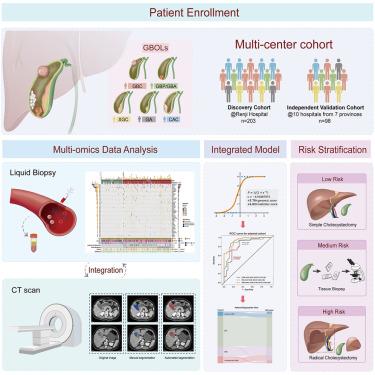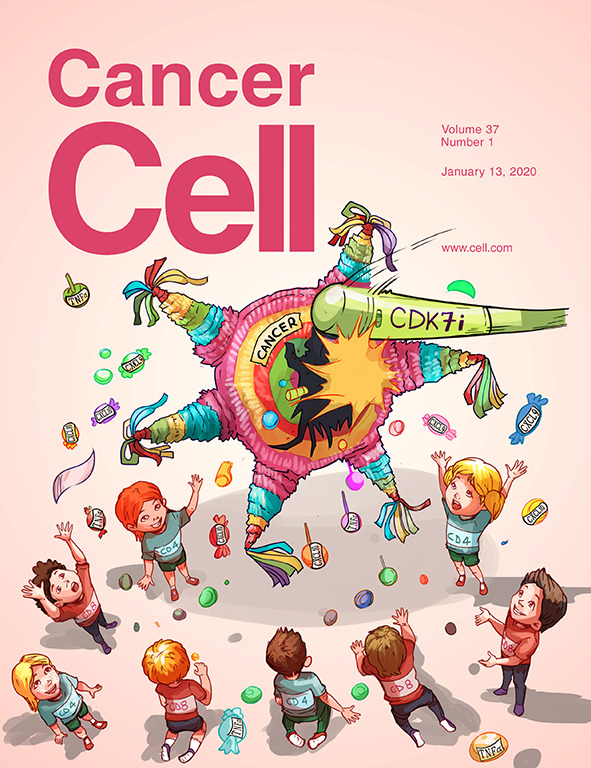Multimodal integration of liquid biopsy and radiology for the noninvasive diagnosis of gallbladder cancer and benign disorders
IF 48.8
1区 医学
Q1 CELL BIOLOGY
引用次数: 0
Abstract
Gallbladder cancer (GBC) frequently mimics gallbladder benign lesions (GBBLs) in radiological images, leading to preoperative misdiagnoses. To address this challenge, we initiated a prospective, multicenter clinical trial (ChicCTR2100049249) and proposed a multimodal, non-invasive diagnostic model to distinguish GBC from GBBLs. A total of 301 patients diagnosed with gallbladder-occupying lesions (GBOLs) from 11 medical centers across 7 provinces in China were enrolled and divided into a discovery cohort and an independent external validation cohort. An artificial intelligence (AI)-based integrated model, GBCseeker, is created using cell-free DNA (cfDNA) genetic signatures, radiomic features, and clinical information. It achieves high accuracy in distinguishing GBC from GBBL patients (93.33% in the discovery cohort and 87.76% in the external validation cohort), reduces surgeons’ diagnostic errors by 56.24%, and reclassifies GBOL patients into three categories to guide surgical options. Overall, our study establishes a tool for the preoperative diagnosis of GBC, facilitating surgical decision-making.

胆囊癌及良性疾病无创诊断中液体活检与放射学的多模式整合
胆囊癌(GBC)经常在放射图像上模仿胆囊良性病变(GBBLs),导致术前误诊。为了应对这一挑战,我们启动了一项前瞻性、多中心临床试验(ChicCTR2100049249),并提出了一种多模式、非侵入性的诊断模型来区分GBC和gbbl。来自中国7个省11个医疗中心的301例诊断为胆囊占位性病变(gbol)的患者被纳入研究,分为发现队列和独立的外部验证队列。基于人工智能(AI)的集成模型GBCseeker利用无细胞DNA (cfDNA)遗传特征、放射学特征和临床信息创建。该方法对GBC和GBBL患者的区分准确率较高(发现队列为93.33%,外部验证队列为87.76%),降低了外科医生的诊断错误率56.24%,并将GBOL患者重新分类为三类,指导手术选择。总的来说,我们的研究为GBC的术前诊断建立了一个工具,便于手术决策。
本文章由计算机程序翻译,如有差异,请以英文原文为准。
求助全文
约1分钟内获得全文
求助全文
来源期刊

Cancer Cell
医学-肿瘤学
CiteScore
55.20
自引率
1.20%
发文量
179
审稿时长
4-8 weeks
期刊介绍:
Cancer Cell is a journal that focuses on promoting major advances in cancer research and oncology. The primary criteria for considering manuscripts are as follows:
Major advances: Manuscripts should provide significant advancements in answering important questions related to naturally occurring cancers.
Translational research: The journal welcomes translational research, which involves the application of basic scientific findings to human health and clinical practice.
Clinical investigations: Cancer Cell is interested in publishing clinical investigations that contribute to establishing new paradigms in the treatment, diagnosis, or prevention of cancers.
Insights into cancer biology: The journal values clinical investigations that provide important insights into cancer biology beyond what has been revealed by preclinical studies.
Mechanism-based proof-of-principle studies: Cancer Cell encourages the publication of mechanism-based proof-of-principle clinical studies, which demonstrate the feasibility of a specific therapeutic approach or diagnostic test.
 求助内容:
求助内容: 应助结果提醒方式:
应助结果提醒方式:


